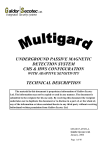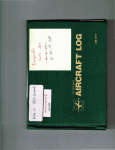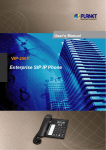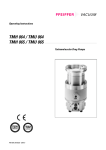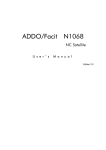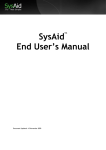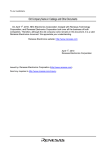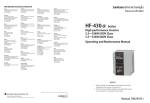Download MUPDS-1000 UPDS-2000 MUPDS-3000
Transcript
aldor ecotec Ltd. Integrated Security systems MUPDS-1000 UPDS-2000 MUPDS-3000 CMS & HWS FIELD CONTROLLERS PRODUCTS SPECIFICATIONS The material in this document is proprietary information of GaldorSecotec Ltd. The information may not be copied or used in any manner. The document is submitted to the recipient for his use only. By receiving this document the recipient undertakes not to duplicate the document or to disclose in a part of, or the whole of, any of the information or ideas contained herein to any third party without receiving beforehand written permission from Galdor-Secotec Ltd. MN-0240-45838-B Galdor –Secotec Ltd. Page 1 of 41 February 2007 Approved by Remarks Date Version Yehuda Rearranged 01/08/2007 45838-B Galdor-Secotec Ltd. 100 Hadar st. Kidron 70795 Israel, Tel. 972-8-8594664 Fax. 972-8-8680172 Page 2 of 41 TABLE OF CONTENTS 1. General................................................................................................................ 4 1.1. UPDS Field Controllers .............................................................................. 6 1.2. The Detection Loops and/or poles ............................................................... 8 1.2.1. Single Loop ............................................................................................. 8 1.2.2. Double Loop Poles................................................................................... 8 1.3. UPDS Sensor cable and Poles Optional....................................................... 9 2. Principle of Operation........................................................................................ 14 3. System Description............................................................................................ 15 3.1. Detection System ...................................................................................... 15 3.2. General Description of Detection System.................................................. 15 3.2.1. Single Loop/Pole configuration.............................................................. 15 3.2.2. Field Controller...................................................................................... 16 3.2.3. Signal processing and setup function description.................................... 17 3.2.4. Automatic BIT Function ........................................................................ 17 3.2.5. Manual Test Function ............................................................................ 18 3.2.6. Power Requirement................................................................................ 18 3.2.7. Communication Unit.............................................................................. 18 4. Electromagnetic Compatibility .......................................................................... 20 5. Signal processing and setup function description ............................................... 20 5.1. Gain control .............................................................................................. 20 5.1.1. CMS Configuration................................................................................ 20 5.1.2. HWS Configuration ............................................................................... 20 5.2. Threshold Level Control ........................................................................... 20 5.2.1. CMS Configuration................................................................................ 20 5.2.2. HWS Configuration ............................................................................... 21 5.3. Event Counting ......................................................................................... 21 5.3.1. CMS Configuration................................................................................ 21 5.3.2. HWS Configuration ............................................................................... 21 5.4. Time Windows ......................................................................................... 21 5.4.1. CMS Configuration................................................................................ 21 5.5. Test function............................................................................................. 21 6. Power Requirement ........................................................................................... 22 7. Power cable ....................................................................................................... 22 8. CMS Controller Alarm Output (M4000 System Inputs) ..................................... 23 9. CMS Controller Inputs M4000 (System Outputs) .............................................. 26 10. Default Processing Parameter for each channel A&B......................................... 27 11. Detection Sensitivity Set-Up.............................................................................. 28 11.1. Event Counting -Remote Control & adaptive ............................................ 28 11.2. Time Windows – Remote Control only ..................................................... 28 11.3. Threshold Level – Remote Control & Adaptive: ....................................... 29 11.4. Detection Gain Control– Remote Control & Adaptive:.............................. 30 12. CMS Address .................................................................................................... 31 13. Test unit ............................................................................................................ 32 13.1. Test Unit Main Features............................................................................ 33 14. Test unit PC requirements.................................................................................. 34 Approved by Remarks Date Version Yehuda Rearranged 01/08/2007 45838-B UPDS &MUPDS CMS&HWS Field Controllers MN-0240-45838-B February 2007 Page 3 of 41 15. Test Command XXXT6 output .......................................................................... 34 16. Drawings ........................................................................................................... 34 Approved by Remarks Date Version Yehuda Rearranged 01/08/2007 45838-B UPDS &MUPDS CMS&HWS Field Controllers MN-0240-45838-B February 2007 Page 4 of 41 1. General The UPDS system is a unique technology that was developed for the Israel Defense Forces to counter terrorist infiltration since the 1970’s. The original models and the updated state of the art today’s version system have been installed at public and private sites in Israel and many countries all over the world. The idea of the development was to have an underground sensor which will be based on the following requirements: • • • • • Concealed system. Passive system. Suitable to all ground and weather conditions. With minimum false alarms due to environment conditions. With 100% probability of detection for an armed intruder. Since the 1970’s the system technology was continuously developed to have better sensitivity, reliability and modern communication. UPDS systems are the latest model comprising all proven feature with a stated of the art of signal processing and communication. The product includes all improvements to meet CE standard to improve the immunity of the Field Controllers and communication hardware to meet the requirement of EMC (Electro Magnetic Compatibility) directive. The outstanding system features are as following: • Full concealed and passive. • A wide rang of Sensor Cable Types, Rugged steel armored sensor cable or regular NYY PVC direct buried cable. • Rugged Field Controller that meets all severe conditions for under ground installation. Approved by Remarks Date Version Yehuda Rearranged 01/08/2007 45838-B UPDS &MUPDS CMS&HWS Field Controllers MN-0240-45838-B February 2007 Page 5 of 41 Effective operation under any type of ground, concrete, asphalt roads, runways, vegetation, between trees and even under water, snow and ice. • Sensor Cable with Multi Winding Configuration with different detection profile including narrow loop for on top of wall installation. • Effective operation in mountain Terrain & underwater installation. • Coverage of up to 1,200 m’ protection by one Field Controller. • Microprocessor based signal processing including: adaptive sensitivity, auto calibrations, smart diagnostics tools, remote test and customize configuration base on flash memory. • Computerized Field Test Unit. • Multiplex computerized communication by using CMS configuration. Modular standard system with coverage of up to 50 km with a single computerized control center. In CMS configuration there are two types of communication: CMS with RS-485 M4000 communication UPDS Field Controller. Or CMS with Delta Modulation M4000 communication UPDS only. Approved by Remarks Date Version Yehuda Rearranged 01/08/2007 45838-B UPDS &MUPDS CMS&HWS Field Controllers MN-0240-45838-B February 2007 aldor ecotec Ltd. Integrated Security systems 1.1. UPDS Field Controllers The following are the standard UPDS Field Controller, Test Unit software and their types No.: GD-9001-45967-B UPDS & M-UPDS Characteristics Catalog& Item No. 45760-B Group Name. & Type no. M-UPDS-1000 1 1MUPDS650 2 3 1MUPDS630 1MUPDS660 4 45693-B 1 2 3 4 5 45954-B 1 2 1TUPDS1000 UPDS-2000 1UPDS1100 1UPDS1200 1UPDS2000 1UPDS4000 1TUPDS2000 M-UPDS-3000 1MUPDS800 1MUPDS900 System Configuration CMS Delta Modulation Double loop 3ch' 3 Zones HWS Double loop 3ch' 3 Zones CMS Delta Modulation Double loop 2ch' single zone Test unit Double loop 3ch Power Net Test Inhibit Direc. Weig. Comm. Comm. In-Out 20-48VDC 5W 9Kg 20-72VDC 5W Yes Yes Yes 20-48VDC 3W Approved by Remarks Date Version Rearranged 01/08/2007 45838-B Yes Yes No yes No yes Yes Yes Yes Yes No No No No Yes Yes Yes Yes Yes Yes 2.5Kg CMS RS-485 Double loop 3ch' Two zones CMS RS-485 Double loop 2ch' Single zone Yehuda Yes Yes 2Kg HWS Single Loop 1ch' Single zone CMS RS-485 Single Loop 1ch' Single zone HWS Single Loop 2ch' Two zones CMS RS-485 Single Loop 2ch' Two zones Test unit Single Loop 2ch' 20-48VDC 5W Yes Yes Galdor-Secotec Ltd. 100 Hadar st. Kidron 70795 Israel, Tel. 972-8-8594664 Fax. 972-8-8680172 Page 7 of 41 Catalog& Item No. 3 1 2 3 1 2 3 4 5 6 7 8 Group Name. & Type no. 1TUPDS3000 UPDSInhibitor 1UPDSIN100 System Configuration-Product description Power Net Test Inhibit Weig. Comm. Comm. Direc. In-Out Test unit Double loop 3ch' CMS Delta Modulation 1UPDSIN200 HWS 1UPDSIN300 CMS RS485 UPDS-MUPDS Accessories Power Protection Kit (Isolation Transformer and Burst & Surge protection unit) Power Starter Card Power Cable End of Line unit Power supply 48-VDC 3-Amp. Sensor Cable Connection Kit Data Cable Connection Kit Grounding Stake Approved by Remarks Date Version Yehuda Rearranged 01/08/2007 45838-B UPDS &MUPDS CMS&HWS Field Controllers 20-48 VDC 3W 7Kg 20-72 VDC 3W 20-48 VDC 3W 1.8Kg 20-48VDC 3W 1.8Kg MN-0240-45838-B February 2007 Yes No No No yes No No No No Page 8 of 41 1.2. The Detection Loops and/or poles The Detection Loops and/or poles, which are connected to the Field Controller detection channels, can be in three configurations: 1.2.1. Single Loop Each single Detection Loop connected to one Field Controller detection channel to create alarm zone. 1.2.2. Double Loop Poles Each alarm zone covered by two detection loops which are close and parallel to each other. 1.2.3. Single Poles Each single Line Detection Pole connected to one Field Controller detection channel to create alarm zone. Approved by Remarks Date Version Yehuda Rearranged 01/08/2007 45838-B UPDS &MUPDS CMS&HWS Field Controllers MN-0240-45838-B February 2007 Page 9 of 41 1.3. UPDS Sensor cable and Poles Optional Option 1. 2. 3. Cable type & description Armored 4x1.5 mm² type 4CBL1040 Armored 4x0.5 mm² type 4CBL1044 Shielded NYY cable 4x22AWG type 4CBL1049 Loop configuration Resistance of each wire (R wire Ω/km ) 4 Windings (N=4) Sub loop size 4m'x1.2m' (f=2.6) 4 Windings (N=4) Sub loop size 4m'x1.2m' (f=2.6) 4 Windings (N=4) Sub loop size 4m'x1.2m' (f=2.6) Max Max. Resistance for length of each loop each loop (R max. Ω) (L loop m' ) Max. cable length for each loop (L t m' ) Recommended max. loop length (m') 13Ω/km Max. 100Ω 738 m' 1,920 m' 600 m' 33.14Ω/km Max. 100Ω 290 m' 754 m' 250 m' 53Ω/km Max. 100Ω 181 m' 470 m' 150 m' Approved by Remarks Date Version Yehuda Rearranged 01/08/2007 45838-B UPDS &MUPDS CMS&HWS Field Controllers MN-0240-45838-B February 2007 Page 10 of 41 Option 4. .5 6. Cable type & description Shielded NYY cable 6x22AWG type 4CBL1003 Shielded NYY cable 8x22AWG type 4CBL1021 Shielded NYY cable 8x22AWG type 4CBL1021 Loop configuration Resistance of each wire (R wire Ω/km ) 6 Windings (N=6) Sub loop size 4m'x0.3m' (f=2.15) 8 Windings (N=8) Sub loop size 4m'x0.3m' (f=2.15) 8 Windings (N=8) Sub loop size 1m'x0.1m' (f=2.2) Max Max. Resistance for length of each loop each loop (R max. Ω) (L loop m' ) Max. cable length for each loop (L t m' ) Recommended max. loop length (m') 53Ω/km Max. 100Ω 146 m' 314 m' 140 m' 53Ω/km Max. 100Ω 109 m' 235 m' 100 m' 53Ω/km Max 100Ω 109 m' 235 m' 100 m' Approved by Remarks Date Version Yehuda Rearranged 01/08/2007 45838-B UPDS &MUPDS CMS&HWS Field Controllers MN-0240-45838-B February 2007 Page 11 of 41 Option 7. Cable type & description Loop configuration Resistance of each wire (R wire Ω/km ) --------- 1.45 Ω/Pole Pole Detection type 1MPL1003 Approved by Remarks Date Version Yehuda Rearranged 01/08/2007 45838-B Max Max. Resistance for length of each loop each loop (R max. Ω) (L loop m' ) Max per zone 100Ω UPDS &MUPDS CMS&HWS Field Controllers Max. cable length for each loop (L t m' ) Recommended max. loop length (m') ----- 130 m' ----- MN-0240-45838-B February 2007 Page 12 of 41 Formulas for calculations of Sensor parameters. Lt [m']= R max [Ω] x 1,000 L loop [m'] = R wire [Ω/km] x N L t[m'] f f= Subloop length (x2) [m'] + subloop width (x2) [m'] Subloop length [m'] Detection Cross Section Subloop size 4m'x1.2m' Subloop size 4m'x0.3m' Approved by Remarks Date Version Yehuda Rearranged 01/08/2007 45838-B UPDS &MUPDS CMS&HWS Field Controllers Subloop size 4m'x1.2m' MN-0240-45838-B February 2007 Page 13 of 41 Subloop size 1m'x0.1m' Approved by Remarks Date Version Yehuda Rearranged 01/08/2007 45838-B UPDS &MUPDS CMS&HWS Field Controllers MN-0240-45838-B February 2007 aldor ecotec Ltd. Integrated Security systems 2. Principle of Operation The UPDS & MUPDS detection systems based on Magnetic Anomaly Detection (M.A.D) principle. (Fig 1, Fig 2). The earth’s magnetic field as an outstanding natural phenomenon, allows the unique electronics of UPDS systems to sense the change of Earth’s magnetic field, due to a movement of ferro magnetic objects crossing sensor cable loops installed underground. M.A.D permits UPDS & MUPDS systems to sense the signal from sensor cable loops, without any additional power except the signal that are generated in the loops due to M.A.D principle. Therefore, the sensor cable loops are completely passive except when M.A.D principle is activated by crossing the loops with Ferro magnetic object. M.A.D permits UPDS system to distinguish between actual intruders and stray animals, birds, winds, heavy rain, fog, snow, ice, sand storm and other bad weather conditions which generally trigger other intrusion systems. Approved by Remarks Date Version Yehuda Rearranged 01/08/2007 45838-B Galdor-Secotec Ltd. 100 Hadar st. Kidron 70795 Israel, Tel. 972-8-8594664 Fax. 972-8-8680172 Page 15 of 41 The unique electronics of the field controller to sense small signal in the level of nano volts coming from sensor loop due to M.A.D principle. The UPDS & MUPDS systems essentially consists three major units: • Detection System – Field Controller and Detection Loops or Poles. • Data and power Cable. • Command & control center. 3. System Description 3.1. Detection System The detection system consists of 2 main units: • Field Controller. • Detection Loops. 3.2. General Description of Detection System The Field Controller is the heart of UPDS system. Each Field Controller controls up to their detection channels as follows: 3.2.1. Single Loop/Pole configuration A single UPDS-2000 Field Controller with two detection loops will create a detection system of two zones. A series of Field Controllers and detection loops in modular construction can create a long line of protection divided into alarm zones up to 600m' long (see the alternative types of sensor cable) . The out come signals from the Field Controller will transmit via data cable to be displayed in the control center. Approved by Remarks Date Version Yehuda Rearranged 01/08/2007 45838-B UPDS &MUPDS CMS&HWS Field Controllers MN-0240-45838-B February 2007 Page 16 of 41 3.2.2. Field Controller Each Field Controller consist the following main sub units: (Fig 6, Fig 7). • • • • • • Analog amplifiers and analog signal processing. EMI protection unit. Microprocessor digital analyzer unit DC to DC power unit. Communication unit. Housing and connection receptacle. The follow are the sub-unit description: • Analog amplifier and analog signal processing. The analog amplifiers and analog signal processing unit consist the following functions: • EMI Protection This protection is an attenuation circuitry which will attenuate any disturbance, constant or transient in between frequencies of 20Hz and 1 GHz. This attenuation will prevent false alarms signal coming from detection loops. • Test Stimulator This function is activated by a Test command coming from the microprocessor via the communication line from the control center. This function creates electromagnetic signal directly on the detection loop input, simulating a real intruder signal which test the entire UPDS system, starting with the integrity of sensor cable, through the analog amplifier, digital signal processing unit, communication interface, and communication line up to the alarm display at the control center. • Selective Amplifier This function is a unique electronic circuit with ultra low noise features enable to pick up from the detection loop a signal of a few Nano volt. Approved by Remarks Date Version Yehuda Rearranged 01/08/2007 45838-B UPDS &MUPDS CMS&HWS Field Controllers MN-0240-45838-B February 2007 Page 17 of 41 • Adaptive threshold Control This function selects remotely and automatically the threshold signal level which above it will create an event pulse to be processed by the microprocessor. • EMI Protection Unit This unit is a combination of a shielded housing and filtering elements which are encapsulated together to protect the three analog amplifiers and analog signal processing units. This unit protects the three analog channels from any direct EMI signal received directly into the analog channels to prevent false alarm. 3.2.3. Signal processing and setup function description The function of the Digital Signal Processing unit is to process all signals coming from the analog channel and to distinguish between true and false alarms created in the Field Controller. The digital Signal Processing unit designed to have smart sensitivity auto calibration. The Signal processing mechanism will probe continually the sensor field condition and adjust it self to the optimum sensitivity. 3.2.4. Automatic BIT Function The system has an automatic BIT function which covers the following: • BIT for the detection unit. • BIT for the system and Field Controller power supply. • BIT for the communication line and transponder (CMS System). • BIT for the alarm center (CMS System). Approved by Remarks Date Version Yehuda Rearranged 01/08/2007 45838-B UPDS &MUPDS CMS&HWS Field Controllers MN-0240-45838-B February 2007 Page 18 of 41 3.2.5. Manual Test Function The system has manual test actuator located at the control room. The operator can activate through the data communication a test generator which is located in each one of the Field Controller. This test generator generates an electromagnetic signal which is induced to the sensor cable to check the integrity of the whole system starting with the sensor cable, through the analog amplifier, digital signal processing, communication interface, communication line up to the display 3.2.6. Power Requirement In order to give a design flexibility for optimize power cable size, the different Field Controller operate from 20VDC up to 48VDC (Vin), Which include Surge and Burst Protection. The power supply should be CE Standard quality with batteries power backup. The total power required is less than 5 watt for three channels Field Controller (power required can become different depending on the type of the Field Controller UPDS & MUPDS). The Field Controller power supply is converted by the internal DC to DC power unit into +/- 12VDC and 6VDC: The 6VDC is used for the analog amplifier and analog signal processing units. Between the Vin and the internal +/- 12VDC there is a ground separation. This feature is achieved by the DC to DC power unit. 3.2.7. Communication Unit The Field Controller is classified according to the type of the communication units. Field Controller with computerized multiplex communication unit is defined as CMS configuration. Field Controller with relay outputs hardwire communication unit, is defined as HWS configuration. Approved by Remarks Date Version Yehuda Rearranged 01/08/2007 45838-B UPDS &MUPDS CMS&HWS Field Controllers MN-0240-45838-B February 2007 Page 19 of 41 3.2.7.1. C.M.S Configuration The CMS configuration is based on integration between Field Controller and M4000 communication module. The module conducts the multiplex communication between the Field Controller and the computerized center. The M4000 system is the alarm command control for Field Controller system. The CMS configuration classified according to the type of the communication as follows. 3.2.7.2. RS485 Communication All data transmit or receive is via twisted and shielded pair of wires (data line). Each RS-485 communication channel can hold up to 30 Field Controller. With the distance of up to 2-4 Km with the dependency on the number of Field Controller on the Communication line, with additional M4000 RS-485 Repeaters units or F/O link to field Interface Card the distance can be much longer. 3.2.7.3. Delta Modulation Communication All data transmitted and received via two twisted shielded pairs. The Delta Modulation electronic and software protocol designed to hold up to 128 field controllers on each communication channel with distance of 10km'. Longer distances are available with additional M4000 Delta modulation repeater. 3.2.7.4. H.W.S Configuration The HWS configuration is based on a direct connection between each one of the alarm outputs to a customized control center. The connection is done via relay contact and multi-core communication cable. The HWS UPDS Controller contains one relay output for each detection channel; the same relay will be activated for any other fault alarm. The rating of the relay contact is 30VDC 100mA. Approved by Remarks Date Version Yehuda Rearranged 01/08/2007 45838-B UPDS &MUPDS CMS&HWS Field Controllers MN-0240-45838-B February 2007 Page 20 of 41 4. Electromagnetic Compatibility Meets all requirements according to CE standard E.M.C. directive 5. Signal processing and setup function description The field Controller designed to have smart sensitivity Auto correction. The Signal processing mechanism will probe continually the sensor field condition and adjust it self to the optimum sensitivity. 5.1. Gain control 5.1.1. CMS Configuration A combination of remote Gain control and the Adaptive Gain mechanism, give the user the ability to control the gain of, each channel separately, to the maximum Gain sensitivity. The Adaptive Gain mechanism will setup automatically the optimum Gain Sensitivity considering of the User selected manual Gain and the System environment conditions. 5.1.2. HWS Configuration A combination of pre defined Gain level (factory set up) and Adaptive Gain mechanism will setup automatically the optimum Gain Sensitivity. 5.2. Threshold Level Control 5.2.1. CMS Configuration A combination of remote and pre defined Threshold Level control with the Adaptive Threshold Level mechanism, give the user the ability to control the minimum Threshold Level, for each channel separately. The Adaptive Threshold Level mechanism will setup automatically the optimum Threshold Level Sensitivity considering the User selected manual level and the System environment conditions. Approved by Remarks Date Version Yehuda Rearranged 01/08/2007 45838-B UPDS &MUPDS CMS&HWS Field Controllers MN-0240-45838-B February 2007 Page 21 of 41 5.2.2. HWS Configuration A combination of pre defined Threshold level (Test Unit set up) and Adaptive Threshold level mechanism will setup automatically the optimum Threshold level Sensitivity. 5.3. Event Counting 5.3.1. CMS Configuration A combination of remote Event Counting control and the Adaptive Event Counting mechanism, give the user the ability to control the sensitivity Event Counting by changing, for each channel separately. The Adaptive Event Counting mechanism will setup automatically the optimum Event Counting Sensitivity considering the User selected manual event counting and the System environment conditions. 5.3.2. HWS Configuration A combination of pre defined Event Counting (Test Unit set up) and Adaptive Event Counting mechanism will setup automatically the optimum Event Counting Sensitivity. 5.4. Time Windows 5.4.1. CMS Configuration Remote control and pre defined (Test Unit set up) united for the two channels. 5.5. Test function CMS Remote only Approved by Remarks Date Version Yehuda Rearranged 01/08/2007 45838-B UPDS &MUPDS CMS&HWS Field Controllers MN-0240-45838-B February 2007 Page 22 of 41 6. Power Requirement External good quality power source of 48VDC which include Surge and Burst Protection connected to Power & Data cable coming out of the controller. Power below 17 VDC will create a low voltage alarm. Power supply at the MDF/IDF should be CE Standard quality with batteries power backup. 7. Power cable The size of power cable depends on the type of the field controller, the distance of field controller from the MDF along the power line and the number of controllers on each branch. The following are typical system configuration which including 48VDC, MDF, Power starter card, power line branch A & B and power cable End of Line Unit. For each option there will be a table with the max resistance of power wires cable which connects each two field controllers – according to the actual distance between controller and the max allow resistance the cable size will be calculated. Option #1 MUPDS 3000 This option contains 13 controllers. 6 controllers on each branch and one controller connected directly to the MDF. The following are the resistance values for a configuration of 5;4;3;2; field controllers on a branch. No. of controllers on a branch 6 5 4 3 2 Max resistance Ω (between controllers. 5.9 7.7 11.3 17.7 30 Approved by Remarks Date Version Yehuda Rearranged 01/08/2007 45838-B UPDS &MUPDS CMS&HWS Field Controllers MN-0240-45838-B February 2007 Page 23 of 41 Option #2 MUPDS 3000 This option contains up to 12 field controllers. 6 controllers on each branch. The following are the resistance values for a configuration of 5;4;3;2; field controllers on a branch. No. of controllers on a branch 6 5 4 3 2 Max resistance Ω (between controllers. 7.5 10 16 26 58 8. CMS Controller Alarm Output (M4000 System Inputs) All alarms including intrusion alarm, electronic fault, sensor fault, Low Voltage and Tamper will be transmitted by the M-4000 RS-485 or Delta Modulation communication to be presented on the color graphic display and/or on the event table. The UPDS uses 2 groups of addresses for each controller. First address for the first group is selected by the user via the DIP switch and the Second address for the second group are calculate automatically by the controller, Second address = [first address + 31]. The address of each alarm event will be as following: G Y A Plugin Interface Number Comm. Channel x x x Controller Address Z Input Number Table 2: M4000 Input object for the UPDS outputs Approved by Remarks Date Version Yehuda Rearranged 01/08/2007 45838-B UPDS &MUPDS CMS&HWS Field Controllers MN-0240-45838-B February 2007 Page 24 of 41 • The "G" is the M4000 communication plug-in prefix. • The "Y" represents the number of the Interface card. • The "A" is the Interface communication channel (can be "A" or "B"). • First 3 digits "xxx" indicate the address of controller (first or second address). • The Z digit indicates the Input No. 1 to 8. Controller Alarm output M-4000 Event Address Description First Address (Non optional objects) Intrusion Alarm Channel A G1AXXX 1 Momentary activated Intrusion Alarm Channel B G1AXXX 2 Momentary activated Not in use G1AXXX 3 Not in use G1AXXX 4 Low voltage G1AXXX 5 Constant alarm Tamper Alarm G1AXXX6 Constant alarm as long tamper is open Technical Fault Channel A: G1AXXX 7 Sensor Cable Cut. Constant or long General Technical Fault. technical fault or cut Technical Fault Channel B: G1AXXX 8 Sensor Cable Cut.. Constant or long General Technical Fault. technical fault or cut 1 2 3 4 5 6 7 8 1 2 3 4 5 6 7 8 Second address ( optional objects) Adaptive Level status channel 1 (bit_0) G1AXXX 1 Adaptive Level status channel 1 (bit_1) G1AXXX 2 Adaptive Level status channel 2 (bit_0) G1AXXX 3 Adaptive Level status channel 2 (bit_1) G1AXXX 4 Adaptive Gain status channel 1 (bit_0) G1AXXX 5 Adaptive Gain status channel 1 (bit_1) G1AXXX 6 Adaptive Gain status channel 2 (bit_0) G1AXXX 7 Adaptive Gain status channel 2 (bit_1) G1AXXX 8 Approved by Remarks Date Version Yehuda Rearranged 01/08/2007 45838-B UPDS &MUPDS CMS&HWS Field Controllers MN-0240-45838-B February 2007 Page 25 of 41 Table 3: M4000 Inputs Description for the UPDS outputs NOTE: All second address inputs are use for reporting status of adaptive sensitivity. This address will be use only for the optional system logic. Approved by Remarks Date Version Yehuda Rearranged 01/08/2007 45838-B UPDS &MUPDS CMS&HWS Field Controllers MN-0240-45838-B February 2007 Page 26 of 41 9. CMS Controller Inputs M4000 (System Outputs) All M4000 Outputs including remote sensitivity control, System Test and Aux. outputs, Will be transmitted from M4000 software via the M4000 RS485 or Delta Modulation communication to the Field Controller. The UPDS uses 2 addresses for each controller. First Address is selected by the user via the DIP switch or by the test unit and the Second address calculate automatically by the controller, Second address = [first address + 31]. The address of each alarm event will be as following: G Plugin y Interface Number A Comm. Channel x x x T Controller Always Address T for Output Z Input Number Table 4: M4000 Output object for the UPDS Inputs • First 3 digits indicate the address of controller. • The next fourth digit indicates the Event No. 1 to 8. The following are the different input functions Events: 1 2 3 4 5 6 7 8 Controller Inputs Description M4000 (M4000 Outputs) Event Address First Address (Non optional objects) Event Counting Channel A G1AXXXT1 Event Counting Channel B G1AXXXT2 Time Windows Channel A & B G1AXXXT3 Threshold Level Channel A G1AXXXT4 Threshold Level Channel A G1AXXXT5 Test Command Channel A & B G1AXXXT6 Momentary activated Threshold Level Channel B G1AXXX T7 Threshold Level Channel B G1AXXXT8 Approved by Remarks Date Version Yehuda Rearranged 01/08/2007 45838-B UPDS &MUPDS CMS&HWS Field Controllers MN-0240-45838-B February 2007 Page 27 of 41 Second address ( optional objects) Local output 1 G1AXXXT1 Local output 2 G1AXXXT2 Not in use G1AXXXT3 Gain Control Channel A G1AXXXT4 Gain Control Channel A G1AXXXT5 Gain Control Channel B G1AXXXT6 Gain Control Channel B G1AXXXT7 Reset Adaptive mechanism G1AXXXT8 1 2 3 4 5 6 7 8 Table 5: M4000 outputs Description for the UPDS Inputs 10. Default Processing Parameter for each channel A&B Description Value 1 Inhibiting time after alarm 15 sec 2 Acceptable Max Event Pulse width 5 sec 3 Acceptable Min Event Pulse width 0.24 sec 4 Event pulse width for Constant Alarm output 10 sec (and longer) 5 Rejected Event Pulse 5 sec – 10 sec 6 Power up time 80 sec Table 6: Processing Parameter NOTE: all the above parameters can be change to meet an actual detection condition by authorized user for using Galdor computerized test unit & Setup software. Approved by Remarks Date Version Yehuda Rearranged 01/08/2007 45838-B UPDS &MUPDS CMS&HWS Field Controllers MN-0240-45838-B February 2007 Page 28 of 41 11. Detection Sensitivity Set-Up 11.1. Event Counting -Remote Control & adaptive The event counting parameter defines how many legal events (see table #6) will be required in the time windows to create an alarm. The user can select the minimum Event counting by setup one of the M-4000 output for each one of the channel individually (see table No.7). The Adaptive Event Counting mechanism will setup automatically the optimum Event Counting Sensitivity considering the User choice and the System environment conditions. XXXT1 Channel A (First Address) Event Counting OFF 2 (High Sensitivity) ON 3 (Low Sensitivity) XXXT2 Channel B (First Address) Event Counting OFF 2 (High Sensitivity) ON 3 (Low Sensitivity) Table 7: Minimum Event Counting - Remote Control Outputs for Com4000XP 11.2. Time Windows – Remote Control only The user can select the required time windows by setup one of the M-4000 output. With this output the user will control from remote witch one of the two (2) time windows is active, the selection is between 6 sec up to 9 sec and will set it on the two channels. XXXT3 Channels A&B (First Address) Time WINDOWS ON 6 sec (Low Sensitivity) OFF 9 sec (High Sensitivity) Table 8: Time Windows - Remote Control Outputs for M4000 Approved by Remarks Date Version Yehuda Rearranged 01/08/2007 45838-B UPDS &MUPDS CMS&HWS Field Controllers MN-0240-45838-B February 2007 Page 29 of 41 11.3. Threshold Level – Remote Control & Adaptive: The user can select remotely the minimum Threshold level by setup Combination of two (2) COM-4000 outputs for each channel individually. The selected Threshold level will be the minimum Threshold Level only for the maximum gain selected by the user. The Adaptive Threshold Level mechanism will setup automatically the optimum Threshold Level Sensitivity considering the User choice and the System environment conditions. If the Gain will move down by the adaptive mechanism the Minimum Threshold level will be change automatically accordingly. XXXT4 (First Address) XXXT5 (First Address) OFF OFF ON OFF ON OFF ON ON XXXT7 (First Address) XXXT8 (First Address) OFF OFF ON OFF ON OFF ON ON Channel A Event Level 1 (High Sensitivity) 2 3 4 (Low Sensitivity) Channel B Event Level 1 (High Sensitivity) 2 3 4 (Low Sensitivity) Table 9: Minimum Threshold Level - Remote Control Outputs for M4000 Approved by Remarks Date Version Yehuda Rearranged 01/08/2007 45838-B UPDS &MUPDS CMS&HWS Field Controllers MN-0240-45838-B February 2007 Page 30 of 41 11.4. Detection Gain Control– Remote Control & Adaptive: A combination of remote Gain control and the Adaptive Gain mechanism, give the user the ability to control, for each of the Separate channel, the maximum Gain sensitivity. The Adaptive Gain mechanism will setup automatically the optimum Gain Sensitivity with consideration of the User choice and the System conditions. The user can select the maximum Gain level by setup Combination of two (2) M-4000 outputs for each channel individually, these two (2) outputs will give the user four (4) Levels of gain option. Gain Control 100% Max 75% Mid Outputs Address (controller Second Address) Channel A XXXT4 XXXT5 OFF OFF ON OFF 1 60% Mid OFF ON 2 50% Min ON ON Outputs Address (controller Second Address) Channel B XXXT6 XXXT7 OFF OFF ON OFF Fine Gain Control 100% Max 75% Mid 1 60% Mid OFF ON 2 50% Min ON ON Table 10: Detection Gain Control - Remote Control Outputs for M4000 Approved by Remarks Date Version Yehuda Rearranged 01/08/2007 45838-B UPDS &MUPDS CMS&HWS Field Controllers MN-0240-45838-B February 2007 Page 31 of 41 12. CMS Address Each controller has two (2) addresses "First address" and "Second Address". First address is selected by the user via DIP switch #S1. The address will be defined by 5 switches (1-5) in binary code to give total of 31 addresses 000 up to 030. The Second Address calculates automatically by the controller by adding 32 to the First address, total sum of 31 addresses 031 up to 061. The following table shows for each one of the First address its Dip switch #S8 setup and the automatically value of Second Address. First Address 0 1 2 3 4 5 6 7 8 9 10 11 12 13 14 15 16 17 18 19 Address on #S1. 1 0 1 0 1 0 1 0 1 0 1 0 1 0 1 0 1 0 1 0 1 2 0 0 1 1 0 0 1 1 0 0 1 1 0 0 1 1 0 0 1 1 3 0 0 0 0 1 1 1 1 0 0 0 0 1 1 1 1 0 0 0 0 4 0 0 0 0 0 0 0 0 1 1 1 1 1 1 1 1 0 0 1 0 Seconded Address 5 0 0 0 0 0 0 0 0 0 0 0 0 0 0 0 0 1 1 0 1 31 32 33 34 35 36 37 38 39 40 41 42 43 44 45 46 47 48 49 50 Approved by Remarks Date Version Yehuda Rearranged 01/08/2007 45838-B UPDS &MUPDS CMS&HWS Field Controllers MN-0240-45838-B February 2007 Page 32 of 41 20 0 0 1 0 21 1 0 1 0 22 0 1 1 0 23 1 1 1 0 24 0 0 0 1 25 1 0 0 1 26 0 1 0 1 27 1 1 0 1 28 0 0 1 1 29 1 0 1 1 30 0 1 1 1 Table 11: Controller address setup 1 1 1 1 1 1 1 1 1 1 1 51 52 53 54 55 56 57 58 59 60 61 13. Test unit The UPDS & MUPDS Test Unit Type 1STSU110 enables the user to test, monitor and update detection parameters of the Field Controller. (See Test unit user manual document MN-0522-45013-C). Figure 1: Test Unit Test Setup Approved by Remarks Date Version Yehuda Rearranged 01/08/2007 45838-B UPDS &MUPDS CMS&HWS Field Controllers MN-0240-45838-B February 2007 Page 33 of 41 13.1. Test Unit Main Features Simple connection of Field controllers via operating box to the Test Unit PC serial port enable the user to do all the necessary sensitivity set up while controller is in full system operation. (See Figure 1). The Test Unit includes up to three channels Real Time Analog & Digital Detection signal display which eliminate the need of voltage measuring device such as DVM or Scope. The Test Unit enables the user to operate and/or measure the following parameters: • Voltage – Vin & Internal power (OK/ Fault). • Real time sample of analog detection signals channel 1 and 2. • Minimum/Maximum of Analog Detection signals channel 1 and 2. • Event Pulse channel 1 and 2. • Alarm channel 1 and 2. • Faults channel 1 and 2. • Communication status with the UPDS • View of legal event information. • Adaptive sensitivity status. • Activate Test Command. • Reset the adaptive sensitivity mechanism to Max sensitivity. • Test unit screen snapshot – manually or by setup of automatic trigger. • Template: download to controller Microprocessor predefine detection parameters. • Select operation mode and setup the automatic sensitivity functions of the controller. Approved by Remarks Date Version Yehuda Rearranged 01/08/2007 45838-B UPDS &MUPDS CMS&HWS Field Controllers MN-0240-45838-B February 2007 Page 34 of 41 14. Test unit PC requirements The following are minimum PC requirements to install the UPDS Test Unit software: • MS Windows 2000 operating system or higher • Pentium 4 type processor, 1500 + MHz • 256 MB RAM • 20 MB of available hard disk space • Microsoft Framework 1.1 • DirectX 9 15. Test Command XXXT6 output Activation of output XXXT6 of the First address for duration of 3 up to 6 seconds will activate Test Routine at the controller microprocessor. 16. Drawings The following drawings are attached: Fig 1: M.A.D Principle of Operation.......................................................... 35 Fig 2: Crossing of Detection Loop by ferromagnetic object ......................... 36 Fig 3: The principle of signal cancellation due to a global change of magnetic field................................................................................................. 37 Fig 4: Double Loop Configuration............................................................. 38 Fig 5: Double loop System Configuration .................................................. 39 Fig 6: M-UPDS & UPDS Field Unit HWS configuration............................. 40 Fig 7: M-UPDS & UPDS Field Unit CMS configuration ............................. 41 Approved by Remarks Date Version Yehuda Rearranged 01/08/2007 45838-B UPDS &MUPDS CMS&HWS Field Controllers MN-0240-45838-B February 2007 Page 35 of 41 Fig 1: M.A.D Principle of Operation Approved by Remarks Date Version Yehuda Rearranged 01/08/2007 45838-B UPDS &MUPDS CMS&HWS Field Controllers MN-0240-45838-B February 2007 Page 36 of 41 Fig 2: Crossing of Detection Loop by ferromagnetic object Approved by Remarks Date Version Yehuda Rearranged 01/08/2007 45838-B UPDS &MUPDS CMS&HWS Field Controllers MN-0240-45838-B February 2007 Page 37 of 41 Fig 3: The principle of signal cancellation due to a global change of magnetic field Approved by Remarks Date Version Yehuda Rearranged 01/08/2007 45838-B UPDS &MUPDS CMS&HWS Field Controllers MN-0240-45838-B February 2007 Page 38 of 41 Fig 4: Double Loop Configuration Approved by Remarks Date Version Yehuda Rearranged 01/08/2007 45838-B UPDS &MUPDS CMS&HWS Field Controllers MN-0240-45838-B February 2007 Page 39 of 41 Fig 5: Double loop System Configuration Approved by Remarks Date Version Yehuda Rearranged 01/08/2007 45838-B UPDS &MUPDS CMS&HWS Field Controllers MN-0240-45838-B February 2007 Page 40 of 41 Fig 6: M-UPDS & UPDS Field Unit HWS configuration Approved by Remarks Date Version Yehuda Rearranged 01/08/2007 45838-B UPDS &MUPDS CMS&HWS Field Controllers MN-0240-45838-B February 2007 Page 41 of 41 Fig 7: M-UPDS & UPDS Field Unit CMS configuration Approved by Remarks Date Version Yehuda Rearranged 01/08/2007 45838-B UPDS &MUPDS CMS&HWS Field Controllers MN-0240-45838-B February 2007









































